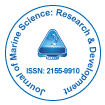当社グループは 3,000 以上の世界的なカンファレンスシリーズ 米国、ヨーロッパ、世界中で毎年イベントが開催されます。 1,000 のより科学的な学会からの支援を受けたアジア および 700 以上の オープン アクセスを発行ジャーナルには 50,000 人以上の著名人が掲載されており、科学者が編集委員として名高い
。オープンアクセスジャーナルはより多くの読者と引用を獲得
700 ジャーナル と 15,000,000 人の読者 各ジャーナルは 25,000 人以上の読者を獲得
インデックス付き
- CAS ソース インデックス (CASSI)
- 索引コペルニクス
- Google スカラー
- シェルパ・ロミオ
- Jゲートを開く
- Genamics JournalSeek
- アカデミックキー
- 研究聖書
- ウルリッヒの定期刊行物ディレクトリ
- 電子ジャーナルライブラリ
- レフシーク
- 研究ジャーナル索引作成ディレクトリ (DRJI)
- ハムダード大学
- エブスコ アリゾナ州
- OCLC-WorldCat
- 学者の舵取り
- SWBオンラインカタログ
- 仮想生物学図書館 (vifabio)
- パブロン
役立つリンク
オープンアクセスジャーナル
このページをシェアする
抽象的な
Assessment of Heavy Metals in Some Marine Fish Species Relevant to their Concentration in Water and Sediment from Coastal Waters of Ondo State, Nigeria
Olusola JO and Festus AA
Due to oil exploration activities and urbanization as well as continuous industrial and agricultural growth in Ondo State, Nigeria. The coastal water has been heavily impacted by a number of pollutants originating from different sources including heavy metals. This investigation assessed and monitored accumulation levels of ( Cr, Cd, Pb, Cu, Zn, and Ni ) in different organs ( Gill, Head, Bone, Muscle and Eye ) of five fish species (Pentanemus quinquarius, Pseudoltolithus senegalensis, Trichirus lepturus, Plectorhynchus meditarraneus and Pseudotolithus typus together with water and sediment collected from the ocean shoreline in the coastal waters of Ondo State, Nigeria. Heavy metals concentrations in fish tissues, water and sediment samples were analyzed after treatment using atomic absorption spectrophotometer. Dissolve total metal in water (in mg/l) Zn 0.12-0.22 , Cu 0.26-0.27 and Ni BDL-0.01 recorded in the water samples in this study were low and within the maximum permissible level (MPL) recommended by WHO and USEPA, while higher concentrations above the MPL were recorded for Cr 0.31-0.34 Cd 0.08 -0.21 and Pb 0.57-0.79. The concentrations of these metals in sediment in (mg/kg) were in the range Cr (0.16-4.19, Cd 0.35-0.38, Pb 0.9-1.00, Cu 0.24-1.44, Zn 2.12-3.11 and Ni BDL-0.01. They are all lower than their probable effect concentrations (PEC) in sediment. Mean Concentrations of the heavy metals in fish species were of the order: Zn>Cu>Cr>Cd>Pb>Ni. Levels of heavy metals varied depending on different tissues in the fish species. Correspondingly, high concentrations of the metals were found in gills and eye compared to other tissues. While the concentration of Zn (0.34 mg/kg-1.29 mg/kg), Cu (BDL-1.88 mg/kg), Ni (BDL-0.01 mg/kg) , and Cr (BDL-1.28) in the fish tissues were within the maximum allowable level (MAL) for a food source, the findings of this study shows higher value above the allowable limit for Cd(BDL-1.14 mg/kg) and Pb (BDL-0.71 mg/kg), thus constituting potential health hazard to consumers of these fish species.

 English
English  Spanish
Spanish  Chinese
Chinese  Russian
Russian  German
German  French
French  Portuguese
Portuguese  Hindi
Hindi